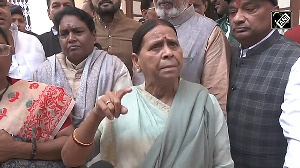There is an irony in Sunil Gavaskar's call for a more exciting brand of one-day cricket.
The opening batsman, one of the game's Test greats, was not himself an instant success in the shorter form of the game.
In the inaugural World Cup in 1975, with India chasing England's 334 for four off 60 overs, he scored 36 not out, including one four, off 174 balls, as his side finished on 132 for three. Earlier in the day, Dennis Amiss had scored 137, taking 27 deliveries fewer than Gavaskar to do so.
It is tempting to ask whether he understood the rules of the game that day.
As the head of the International Cricket Council's (ICC) cricket committee, though, Gavaskar had a point when arguing last week that a tweak in the rules was needed to revitalise a discipline that had become "a little predictable".
Australia coach John Buchanan agreed after his side beat Pakistan in a triangular series final this month. Australia, he said, played "some ugly one-day cricket" to win, and he added: "I think it's a tired old format, but that's what the rules are and that's what we play to."
Once, the one-day game was regarded as cutting-edge excitement. The first international came about by accident, courtesy of some dreary Melbourne weather.
It was 1970, seven years before Kerry Packer. Three days of rain had killed off the third Test between Australia and England without a ball being bowled. The sides agreed to play a 40-over game instead and 46,000 people turned up.
"We won it but we didn't really know what we were doing," Australian batsman Bill Lawry said later.
COLOURED CLOTHES
Within five years, the first World Cup had been played and Packer added impetus to the revolution when his television station was refused the rights to Australia's matches.
Out of frustration he founded a breakaway World Series. He would eventually rejoin the fold, but only after introducing coloured clothes, drop-in pitches and floodlights.
| |||||||||||
It also evolved. Rule tinkering, particularly restrictions in the number of fielders allowed in the outfield during the first 15 overs, helped the all-or-nothing Sri Lankans to rewrite the game's tactics as they stormed to the 1996 World Cup.
Innovation, however, has largely dried up. Many games began to follow a format. Batting sides start fast, farm singles between the 15th and 40th overs as the fielders head for the boundary edge, then attack in the last 10.
For those mid-overs, spectators find themselves in limbo, waiting for the real business to begin.
Signs of discontent have been around for a while. Back in 2000, Packer was already complaining that the one-dayers had run out of steam, suggesting -- as Gavaskar is now -- those 15 overs of fielding restrictions should be broken up into five-over segments, with the batting side choosing when they should occur.
Overselling was another problem. Hardly a day goes by when a one-day international is not being staged somewhere in the world.
World Cups, while retaining their sense of occasion, were also vulnerable. In 2003, the presence of teams such as Namibia, Canada and the Netherlands made for a string of almost meaningless matches in a tournament, which extended to seven weeks.
FAMILY ENTERTAINMENT
A new form of the game, therefore, was probably inevitable. Various formats have been tried and devised, indoor and out, but Twenty20 now appears to have got a significant foothold.
If 50-over matches are junk food, then the 20-over blitz offers an action-packed snack.
Crucially, it takes only three hours. Under lights, it provides perfect family entertainment after work hours.
Purists may see it as a baseball-style slog-fest but in England its first two seasons as part of the county circuit have been hugely successful in attracting a new audience.
The South Africans, New Zealanders and Australians are being won over. New Zealand will stage the first Twenty20 international against Australia in Auckland on February 17, while England and Australia will clash during the 2005 Ashes series.
Suddenly, one-day internationals find themselves sandwiched between real cricket and mad cricket. Some question their very future.
The dominant Australians, in any case, play Test cricket at such a rate nowadays -- and often go on all-out attack while bowling in the one-dayers -- that the two games look increasingly alike.
Most commentators, including Buchanan, believe one-day internationals will survive alongside their two cousins. Others, such as Pakistan captain Inzamam-ul-Haq, believe the latest hybrid may eventually prove the most popular of all.
Gavaskar's first priority will be to ensure that the 50-over game does not lose any more fans. He may be asked to show a little more urgency than he sometimes did with bat in hand.







 © 2025
© 2025